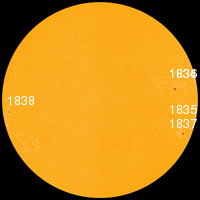QUIET SUNSPOTS: All of the sunspots on the Earthside of the sun are stable and quiet. NOAA forecasters estimate a slight 5% chance of M-class solar flares and no more than a 1% chance of X-class flares on Sept. 6th. Solar flare alerts: text, voice.
MOON ROCKET LAUNCH TONIGHT: Tonight, Sept. 6th at approximately 11:27 p.m. EDT, a Minataur V rocket carrying NASA's LADEE moon probe will blast off from the Wallops Flight Facility in Virginia. Sky watchers along a broad swath of the US east coast from Maine to the Carolinas can see the launch. Orbital Sciences Corp. prepared this visibility map:
In most locations, the ascending rocket won't climb much more than 10° to 15° above the horizon, although areas around the launch site will fare better. Orbital Sciences' prediction page lays out the details of when and which way to look.
The launch will kick off LADEE's mission to investigate the Moon's surprising atmosphere. Yes, the "airless Moon" has an atmosphere. It is ten thousand billion times thinner than Earth's, but nevertheless there. Apollo astronauts actually saw it with their own eyes.
LADEE, short for "Lunar Atmosphere and Dust Environment Explorer," will circle the Moon on a 100 day mission to assay the lunar atmosphere. Instruments onboard the spacecraft will look for signs of humidity, electrified dust, and atoms hopping across the lunar surface. A NASA video about LADEE previews the mission.
Photographers, if you catch LADEE blasting off, submit your images here.
Realtime Space Weather Photo Gallery
SOLAR ECLIPSE: Twice every year, around the time of the equinoxes, Earth can pass directly between the Sun and NASA's Solar Dynamics Observatory (SDO), producing a series of beautiful eclipses from the point of view of the spacecraft. SDO's autumnal eclipse season began this week, producing a partial blackout of the sun:
During the eclipse, which was centered around 0658 UT on Sept. 2nd, Earth covered about half of the sun. Because these eclipses typically last for only minutes each day (maximum=72 minutes), there is still plenty of uninterrupted time for SDO to monitor activity on the sun. The ongoing eclipse season will end on Sept. 25th. Between now and then, stay tuned for some rare blackouts.

Solar wind
speed: 390.1 km/sec
density: 2.0 protons/cm3
explanation | more data
Updated: Today at 1627 UT
X-ray Solar Flares
6-hr max: B5 1519 UT Sep06
24-hr: B5 1519 UT Sep06
explanation | more data
Updated: Today at: 1600 UT
![]()
Daily Sun: 06 Sep 13
The Earthside of the sun is quiet. Solar activity is low. Credit: SDO/HMI
![]()
Sunspot number: 75
What is the sunspot number?
Updated 06 Sep 2013
Spotless Days
Current Stretch: 0 days
2013 total: 0 days (0%)
2012 total: 0 days (0%)
2011 total: 2 days (<1%)
2010 total: 51 days (14%)
2009 total: 260 days (71%)
Since 2004: 821 days
Typical Solar Min: 486 days
Update 06 Sep 2013
The Radio Sun
10.7 cm flux: 110 sfu
explanation | more data
Updated 06 Sep 2013
![]()
Current Auroral Oval:
Switch to: Europe, USA, New Zealand, Antarctica
Credit: NOAA/POES
![]()
Planetary K-index
Now: Kp= 2 quiet
24-hr max: Kp= 2 quiet
explanation | more data
Interplanetary Mag. Field
Btotal: 4.4 nT
Bz: 3.4 nT south
explanation | more data
Updated: Today at 1627 UT
![]()
Coronal Holes: 06 Sep 13
There are no large equatorial coronal holes on the Earthside of the sun.Credit: SDO/AIA.






